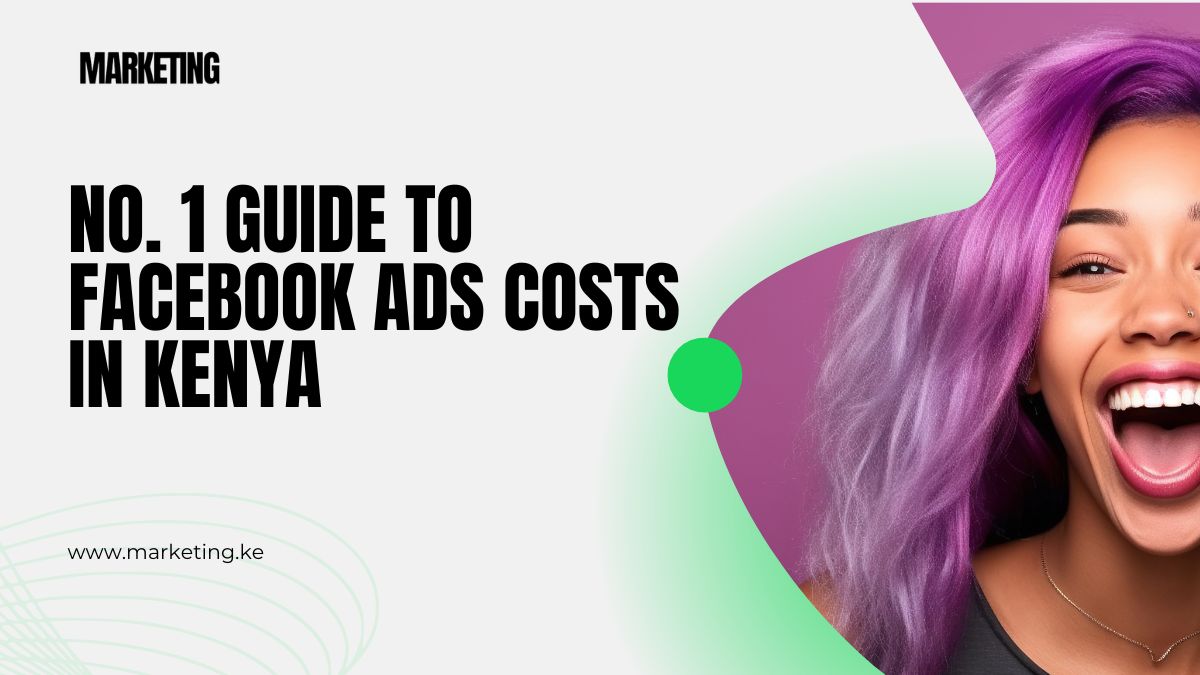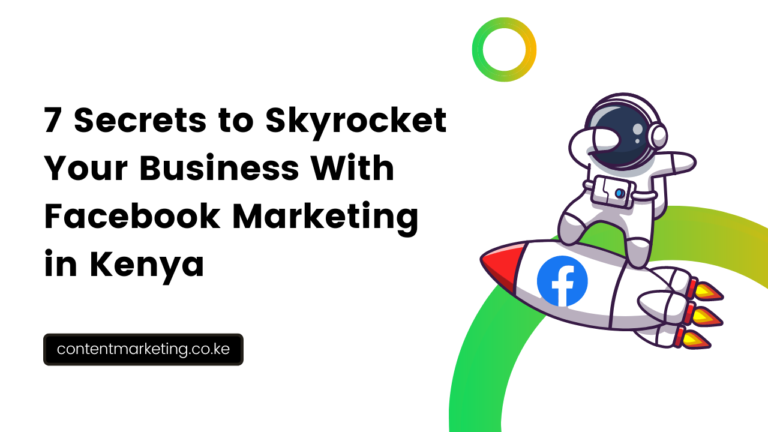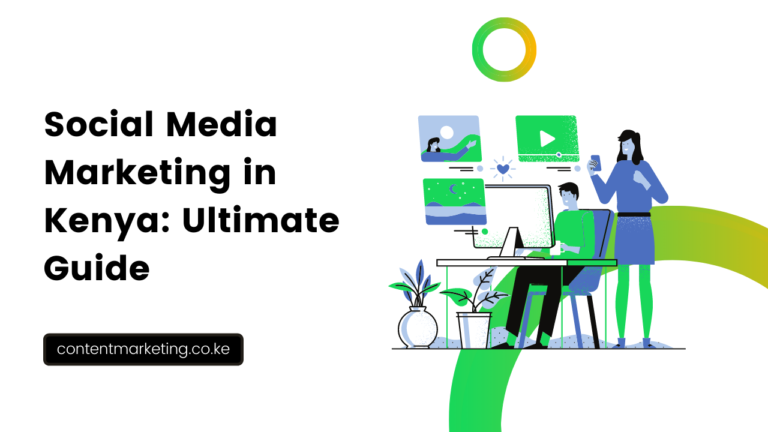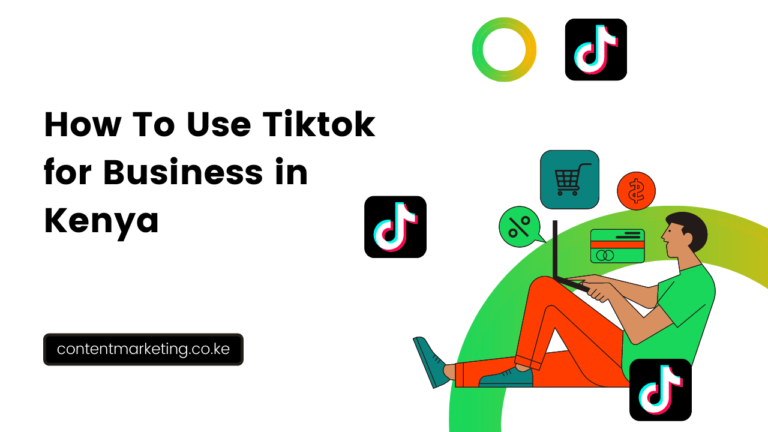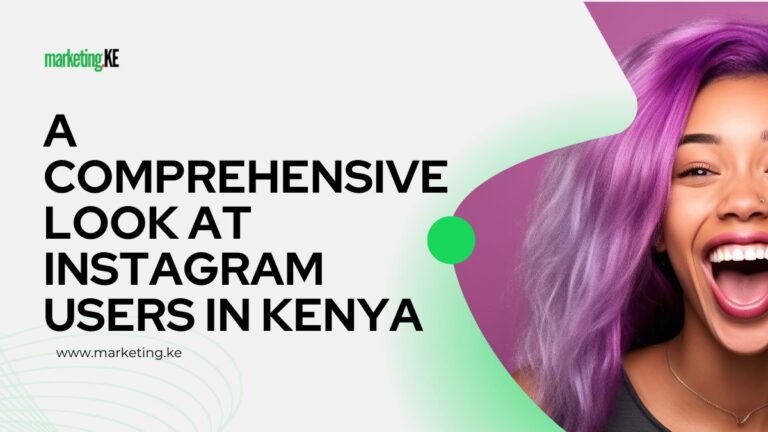No. 1 Guide To Facebook Ads Costs in Kenya
Facebook ads have become an essential marketing tool for businesses in Kenya looking to reach new audiences and drive sales.
As of January 2024, there were over 16.4 million Facebook users in Kenya, representing 28.1% of the population.
In May 2023, the number of Facebook users in Kenya was over 14 million, accounting for 24.4% of the population.
This indicates a significant presence of Facebook in Kenya, making it the largest and most popular social media platform in the country.
However, many businesses are unsure of the costs associated with running Facebook ad campaigns in Kenya.
This article will provide an overview of the key factors that influence Facebook ads costs in Kenya, including audience targeting, placement, and campaign objectives.
We’ll also look at estimated costs for different campaign types and sizes to help you plan your Facebook ad budget.
How much does a Facebook ad cost in Kenya?
The cost of advertising on Facebook in Kenya can vary depending on several factors. The average cost per click (CPC) ranges from Ksh5 to Ksh20, and the average cost per impression (CPM) ranges from Ksh200 to Ksh1000.
The average CPC for the interest “Kenya” is $0.29, and the average CPM is $5.43.
Additionally, the estimated monthly cost for Facebook ads in Kenya is between 10,000 and 50,000 KES.
Note that the cost can be influenced by the type of ad, target audience, ad budget, and the industry.
Therefore, the cost of a Facebook ad in Kenya is not a fixed figure and can vary based on these factors.
Let’s discuss that, shall we?
Audience Targeting
The audience you want to target is one of the main factors determining Facebook ads cost in Kenya.
Facebook lets you target users based on location, demographics, interests, behaviors, and connections.
The more specific your targeting, the more efficiently you can reach your ideal customers. However, smaller targeted audiences often come at a higher cost per click or impression.
Here are some audience targeting options and how they impact ad costs:
- Location: You can target users by country, region, city, or within a custom radius from a location. Targeting specific cities like Nairobi or Mombasa will be more expensive than broader targeting of all of Kenya. The more localized your targeting, the higher the potential reach and relevance but also higher costs.
- Demographics: Target users by age, gender, relationship status, education level, workplace, job titles, and more. Demographic targeting helps refine your audience but can increase costs, especially if you select multiple specific parameters. For example, targeting 18-24 year old college students in Nairobi costs more than targeting 18-65+ ages in all of Kenya.
- Interests: Build audiences based on Facebook pages/content they’ve liked or engaged with. This can help attract people interested in your products/services but costs more per reach than broader targeting.
- Behaviors: Target people based on purchase behaviors, intent signals, device usage, and other actions. While effective for conversions, behavior targeting is expensive for new customer acquisition.
- Connections: Reach people connected to your Facebook page, Messenger contacts, or customer list. Great for retargeting but costs more than targeting interests.
Recommendation: Test broader audience targeting first, then refine based on performance data. Limit your targeting criteria and use interest-based audiences for new campaigns to balance costs and reach.
Placement
Where you choose to display your Facebook ads also affects the costs in Kenya.
Facebook offers a wide range of placement options across Facebook, Instagram, Messenger, and Audience Network sites/apps.
Each placement has its own unique audience, targeting capabilities, and costs per result.
Here are some top placements and how they impact Facebook ad costs in Kenya:
- Facebook News Feed: Appears in middle of Facebook users’ news feeds. Broad reach and flexible targeting makes it the most popular placement. Cost per click can be as low as Ksh 2.
- Facebook Right Column: Ads display in sidebar on right of Facebook page. Cheaper than News Feed but lower visibility and click-through rates. Cost per click around Ksh 1.50.
- Instagram News Feed: Appears in Instagram followers’ feeds. Great for image/video ads. Avg. CPC is Ksh 3-5 for Kenya audiences.
- Instagram Stories: Full screen ads in between Instagram Stories. Limited time slots but high visibility. CPC around Ksh 5.
- Messenger: Ad appears as sponsored message in Messenger inbox. Very targeted based on opt-in users. CPC ranges from Ksh 10-15.
- Audience Network: Display ads on third-party apps/sites in Facebook’s network. Reach new audiences cheaply (CPC < Ksh 2) but untargeted.
Recommendation: Test a mix of placements. Start with lower cost options like Facebook Right Column and Audience Network, then add News Feed. Use Instagram for visually engaging creatives.
Campaign Objective
Your campaign objective will determine your Facebook ads costs in Kenya.
Facebook offers different campaign objectives optimized for specific goals like awareness, conversion, or traffic.
Choosing the objective that best matches your goals will impact cost and results.
Here are some of the key campaign objectives and typical costs:
- Awareness: Build brand awareness or reach. Cost per 1,000 impressions (CPM) ranges from Ksh 100-200.
- Consideration: Drive interest in products/services. CPM around Ksh 150-250.
- Traffic: Increase site visits or app installs. Cost per click (CPC) between Ksh 2-5.
- Engagement: Get more reactions, comments, shares. CPC around Ksh 2-4.
- Video Views: Increase video views. Average cost per view is Ksh 10-20.
- Conversions: Optimize for conversions like sales or lead gen. CPC/CPA can be Ksh 10+.
- Catalog Sales: Promote product catalog and optimize for purchases. CPC around Ksh 10-15.
Recommendation: Start with cheaper awareness/traffic objectives to grow reach. Then use conversion optimization for sales. Video and engagement goals work best for branded content and social growth.
Campaign Budget and Duration
Your overall Facebook ad budget and duration also impacts cost per result in Kenya.
In general, the more you spend and the longer you run campaigns, the cheaper each conversion gets thanks to Facebook’s optimization over time.
Here are benchmarks for campaign budgets and duration to consider:
- Small budget ( Don’t expect the most optimized costs per conversion. CPC may be Ksh 10-20 to start. Plan short duration campaigns like 2-4 weeks.
- Medium budget (Ksh 50,000 – 500,000/month): Facebook has more data to optimize. CPC can decrease to Ksh 5-10 for targeted conversions after 2-3 weeks. Plan month long campaigns.
- Large budget (>Ksh 500,000/month): Big budgets allow Facebook bidding algorithms to drive down CPC over time. For conversions, CPC could go below Ksh 5 with 2-3 month campaigns or longer.
- Ongoing budgets: Without hard end dates, CPCs will gradually decrease as Facebook optimizes. Keep top performing placements/audiences and pause low performers.
Recommendation: Set campaign budgets based on sales/conversion targets and expected values. Start with smaller teste budgets, then scale up for ongoing optimization.
Ad Creation
Your ad creative – both images and text – influences results and Facebook ads costs in Kenya.
Well-targeted, engaging ads improve click-through and conversion rates, which lowers cost per result.
Follow these best practices for creating effective Facebook ads:
- Use high-quality, eye-catching images: Visually appealing graphics in the proper formats (1200×628, 1080×1080, etc) attract more attention in the small ad space.
- Write clear, concise copy: Get your message across quickly in short headlines and descriptions. Highlight value props, promotions, or calls to action.
- Test different headlines: The headline makes the biggest impact in ads. A/B test multiple options and see what resonates most.
- Personalize for audience interests: Tailor ad messaging to your target demographics and what motivates them. Avoid generic copy.
- Use video for engagement: Video ads have higher view rates than images alone. They tell a story and convey emotion for stronger persuasion.
- Show social proof: Include things like reviews, testimonials, or follower counts to build credibility and trust.
- Mobile optimization: Design ads to stand out on small screens and load quickly to improve engagement.
Recommendation: Spend time crafting high-converting ad creatives even if it means starting with a lower budget to test. The ROI is worth the upfront effort.
Measurement and Optimization
The key to getting the most from your Facebook ad spend in Kenya is continuously measuring results and optimizing campaigns.
Use Facebook’s analytics tools to identify top-performing elements and weed out what’s not working.
Follow these optimization best practices:
- Track conversion events: Install Facebook pixel to measure actions taken on your site from ads. Identify your goal conversion to optimize (lead, purchase etc).
- Analyze campaign metrics: Review campaign cost per result, CTR, impressions, reach, frequency, conversions, and relevance scores.
- Breakdown ad sets: See what placements, creatives, audiences, etc are driving best results and lowest costs.
- Test new variants: Try different combinations of targeting, creative, placements to improve performance. Set up A/B ad tests.
- Bid adjustments: Increase bids on best performing elements to get more impressions and decrease for worst. Facebook will optimize.
- Create lookalike audiences: Use your top converting audiences for lookalike targeting and find more potential customers.
- Remarket engaged users: Create custom audiences from video viewers, site visitors etc to re-engage them with special offers.
- Review changes over time: Facebook takes time to optimize new elements
How do I pay for Facebook ads in Kenya?
You have two main options for paying for Facebook ads in Kenya:
1. Credit/Debit Card:
- This is the most common option globally, but not everyone in Kenya has access to these cards.
- If you do have a valid credit/debit card (Visa, Mastercard, American Express), you can add it to your Facebook Ads Manager account under Payment Settings.
- Ensure your card information is accurate and linked to a Kenyan billing address.
2. M-Pesa:
- This is a popular mobile money platform in Kenya, allowing you to pay directly from your phone.
- To use M-Pesa, you’ll need to have an active Lipa na M-Pesa account and sufficient funds.
- During checkout in Facebook Ads Manager, select “Lipa na M-Pesa” as the payment method.
- You’ll receive a prompt on your phone to authorize the payment, confirming the amount and your M-Pesa PIN.
How to pay Facebook ads in Kenya using M-Pesa
To pay for Facebook ads in Kenya using M-Pesa, you can follow these steps:
Using Lipa na M-Pesa:
- Click on M-Pesa and type the amount you want to pay.
- Wait for the payment page to load and enter your M-Pesa number.
- Enter your M-Pesa PIN in the Safaricom pop-up menu to authorize the payment.
Using Flutterwave:
- Facebook has partnered with Flutterwave to allow for easy payments of Facebook ads by Kenyan users through M-Pesa.
Alternative Payment Methods:
- Meta (the parent company of Facebook) accepts credit cards, debit cards, or PayPal for running Facebook ads in Kenya.
Key Takeaways
- Facebook ads costs in Kenya vary based on targeting, placements, campaign objectives, budgets and ad optimization over time.
- Start with broader targeting and lower cost placements to test new campaigns. Then refine targeting and use higher value placements once proven out.
- Conversion-focused objectives generally cost more per click or action than awareness campaigns. Factor in expected conversion values when setting budgets.
- Give Facebook’s algorithms sufficient budget and time (2-3 weeks minimum) to optimize ad delivery and decrease costs.
- Well-targeted, high-quality ad creatives improve results and lower costs. Continuously test and optimize campaigns.
- Measure analytics and focus spend on best performing elements while pausing underperformers. Remergeting and lookalike audiences also boost performance.
Read also:

